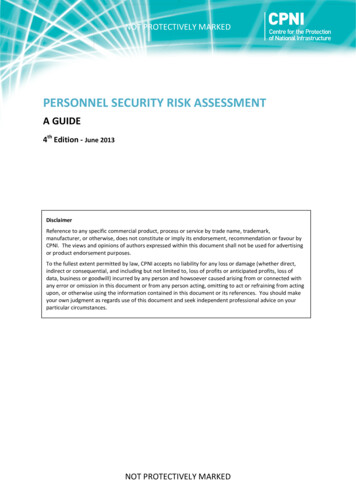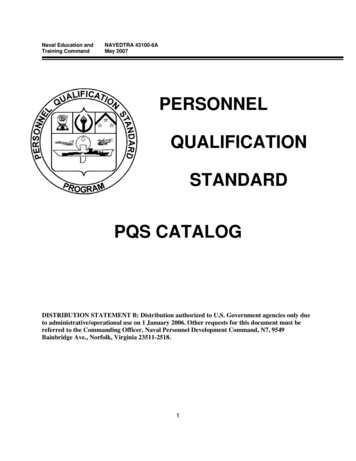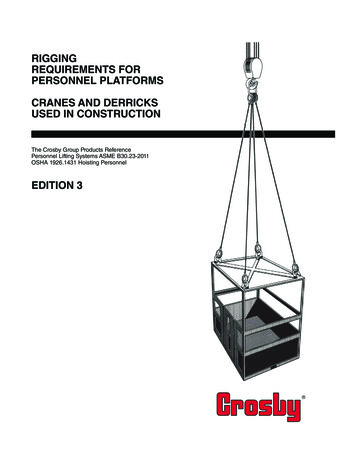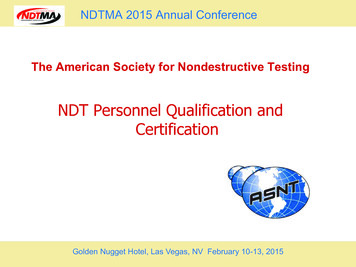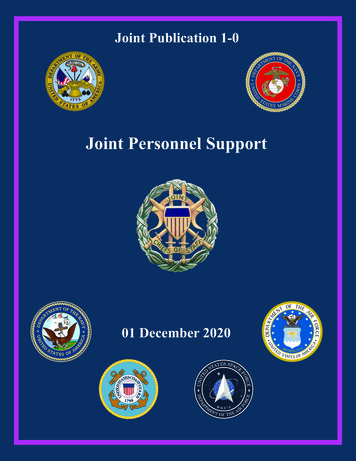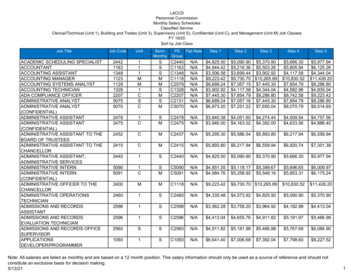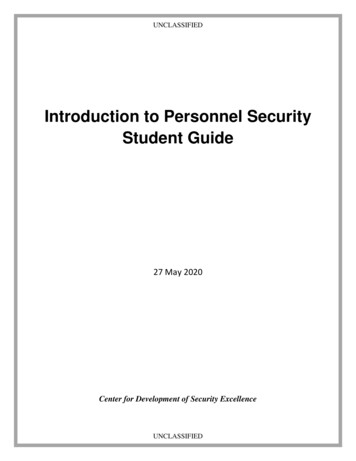
Transcription
UNCLASSIFIEDIntroduction to Personnel SecurityStudent Guide27 May 2020Center for Development of Security ExcellenceUNCLASSIFIED
Introduction to Personnel SecurityStudent GuideProduct #: PS113.16Introduction to Personnel SecurityLesson 1: Course IntroductionThe objective of the Personnel Security Program is to make a reasonable determination thatindividuals granted access to classified information or assigned to sensitive positions are and willremain loyal, trustworthy, and reliable.Consequently, all security specialists are tasked with understanding the Personnel SecurityProgram, or PSP. It is necessary to have a thorough understanding of its origins and processes.Course Objectives: Demonstrate comprehension of the Personnel Security Program (PSP).Explain National Security sensitive position designations and special accessrequirements.Apply investigative process and comprehend the national security adjudicationrequirements.Identify security specialist’s responsibilities under the PSP.Analyze the continuous evaluation and reinvestigation requirements.Course Lessons: Course IntroductionThe Personnel Security ProgramPosition Designations and Special Access RequirementsInvestigation and AdjudicationInvestigative Service Providers and Record KeepingContinuous Evaluation and ReinvestigationThe Security SpecialistCourse SummaryC2 Technologies, Inc.Page 2
Introduction to Personnel SecurityStudent GuideProduct #: PS113.16Lesson 2: The Personnel Security ProgramThis lesson will cover the definition and purpose of personnel security, PSP history, personnelsecurity policies, and major components of the PSP.Lesson Objectives: Comprehend the definition and purpose of personnel securityExplain the history behind the creation of the Personnel Security Program (PSP)Identify personnel security policyIdentify the major components of the PSPThe Purpose of the Personnel Security ProgramThe PSP aims to protect national security by ensuring that only loyal, trustworthy, and reliableindividuals may access classified information and/or be assigned to national security sensitivepositions.The PSP establishes the standards, criteria, and guidelines upon which personnel securitydeterminations are based. The PSP uses a comprehensive background investigative process tomake this determination.The investigative process applies to members of the Armed Forces, DoD civilian employees,DoD contractors, and other affiliated people who require access to classified information or whoare assigned national security sensitive duties.The goal of the PSP is to ensure the protection of national security. Two key aspects of the PSP –providing access to classified information and ensuring the protection of national security.Access to Classified InformationUnauthorized disclosure of classified or sensitive information can cause significant harm tonational security. Information that requires special protection is known as national securityinformation and may be designated as “classified.”In the U.S., there are three levels of classified information: Top Secret, Secret, and Confidential.The degree of damage to national security that could result from its unauthorized disclosuredetermines which classification applies.Top Secret is the highest level of classification. It applies to information that reasonably could beexpected to cause exceptionally grave damage to the national security if unauthorized disclosureoccurs.Secret classification applies to information that could be expected to cause serious damage to thenational security if unauthorized disclosure occurs. Confidential classification applies toinformation that reasonably could be expected to cause damage to the national security ifC2 Technologies, Inc.Page 3
Introduction to Personnel SecurityStudent GuideProduct #: PS113.16unauthorized disclosure occurs.National security encompasses both the national defense and the foreign relations of the U.S.which must be protected from harmful individuals, organizations, and nations.One way a nation can defend itself is to maintain a good working relationship with othercountries, thereby reducing threats to our nation’s survival. Unfortunately, some national securitythreats faced by the United States come from individuals who are already inside.These are known as insider threats. Therefore, assigning individuals who possess a history ofbeing loyal, trustworthy, and reliable to sensitive positions is critical to protecting andmaintaining our national security.Character Traits of Cleared EmployeesThe United States Government expects cleared employees to be loyal, trustworthy, and reliable.But, how do we determine if individuals with a need to access national security informationpossess these traits?Three questions are asked of everyone who has a need for access to classified or sensitiveinformation. Is the individual’s allegiance solely with the United States and its basic form ofGovernment? Can the individual be trusted to properly protect classified information and/orperform other sensitive duties? Is the individual consistently willing and able to carry outsecurity responsibilities?The answer to all of the above questions should be yes.The History of the PSPThis Course will also cover the history of the PSP to better understand what it has become today.Prior to the Civil Service Act of 1883, federal employees, even at the lowest levels, werepolitical appointees.The system by which people were appointed to civil service jobs was called the Spoils System.This system required allegiance to the party boss and the political party that appointed you, asopposed to a larger sense of allegiance to the Constitution. The employee was presumed to beloyal because in the past, he or she was loyal to the party and the party boss. The employee wonthe job as a favor from the party and could only keep it by staying in the party’s favor. Thisprovided a powerful impetus to keep employees 'party-loyal'.Because of the many abuses of the Spoils System, such as incompetent and corrupt politicalofficials, or civil servants who felt they were working for the party rather than the Americanpeople, Congress passed the Civil Service Act in 1883.The Civil Service Act created the U.S. Civil Service Commission. The act required employeesbe appointed on the basis of ability, which was demonstrated by taking an exam. This createdC2 Technologies, Inc.Page 4
Introduction to Personnel SecurityStudent GuideProduct #: PS113.16uncertainty about the partisan allegiance of federal employees who were no longer dependentupon the party favor to keep their jobs. Their party loyalty could no longer be 'bought' ornecessarily even depended upon.Eventually, Congress passed the Hatch Act of 1939, which limits certain political activities ofFederal employees. It ensures administration of federal programs in a nonpartisan fashion.Moreover, the Hatch Act protects Federal employees from political coercion in the workplace. Itmakes certain that Federal employees receive advancement based on merit and not based onpolitical affiliation.Executive Orders, Policies, Regulations, and GuidelinesThe Personnel Security Program is governed by several executive orders, or E.O.s, policies,regulations, and guidelines.Executive Orders: E.O. 10450E.O. 10450, Security Requirements for Government Employment, establishes securityrequirements for government employment. Each civilian officer or employee in any departmentor agency of the Government shall be made subject to investigation. The scope of theinvestigation shall be determined according to the degree of adverse effect on the nationalsecurity that the occupant of the position could bring about,Executive Orders: E.O. 10865E.O. 10865, Safeguarding Classified Information within Industry, requires all persons who areemployed by the departments and agencies of the government to be reliable, trustworthy, of goodconduct and character, and of complete and unswerving loyalty to the United States.Executive Orders: E.O. 12968E.O. 12968, Access to Classified Information and Background Investigative Standards,establishes a uniform federal Personnel Security Program for employees who are considered forinitial or continued access to classified information. This order also establishes Security policiesdesigned to protect classified information.Executive Orders: E.O. 13467E.O. 13467, Reforming Processes Related to Suitability for Government Employment, Fitnessfor Contractor Employees, and Eligibility for Access to Classified National Security Information.This executive order authorizes the continued evaluation of personnel who hold an activenational security eligibility determination. It designates the Director of National Intelligence asthe “Security Executive Agent” (SecEA) with responsibility over security and public trustclearance processing, and the Office of Personnel Management as the “Suitability ExecutiveAgent” with continued responsibility and authority for federal employment suitabilityinvestigations and determinations and authorizes continuous evaluation of personnel who hold anactive national security clearance.C2 Technologies, Inc.Page 5
Introduction to Personnel SecurityStudent GuideProduct #: PS113.16Executive Orders: E.O. 13764E.O. 13764, Amended the Civil Service Rules, was directed toward amending the Civil ServiceRules, Executive Order 13488, and Executive Order 13467 to Modernize the Executive BranchWide Governance Structure and Processes for Security Clearances, Suitability, and Fitness forEmployment and Credentialing, and related matters.Security Executive Agent Directives (SEADs)There are three Security Executive Agency Directives, or SEADs, that are important ingoverning the PSP.SEAD 3 - Reporting Requirements for Personnel with Access to Classified Information or WhoHold a Sensitive Position, establishes reporting requirements for all covered individuals whohave access to classified information or hold a sensitive position. This Directive does not limitthe authority of agency heads to impose additional reporting requirements in accordance withtheir respective authorities under law or regulation.SEAD 4 - National Security Adjudicative Guidelines, establishes the single, commonadjudicative criteria for all covered individuals who require initial or continued eligibility foraccess to classified information or eligibility to hold a sensitive position. National SecurityGuidelines contained in SEAD 4 supersede all previously issued national security adjudicativecriteria or guidelines. Appendix B of SEAD 4 contains the language of the Bond Amendment.SEAD 6 - Continuous Evaluation, reforms processes related to suitability for governmentemployment, fitness for contractor employees, and eligibility for access to classified nationalsecurity information. Specifically, SEAD 6 establishes policy and requirements for thecontinuous evaluation (CE) of individuals who require continued eligibility for access toclassified information or eligibility to hold a sensitive position.CE modernizes the background investigation process by maximizing automated records checksto identify adjudicative relevant information to assist in assessing the continued eligibility ofindividuals at any time during their period of eligibility.Bond AmendmentPassed in 2008, the Bond Amendment repealed Title 10 U.S.C. Section 996 (formerly known asthe Smith Amendment) and placed restrictions that are similar to the Smith Amendment, butwhich apply to all Federal Government Agencies. The Bond Amendment bars persons fromholding a national security eligibility for access to Special Access programs (SAPs), RestrictedData, and Sensitive Compartmented Information (SCI), if they have been convicted of a crimeand served more than one year of incarceration, were discharged from the Armed Forces underdishonorable conditions, or were determined to be mentally incompetent by a court oradministrative agency.C2 Technologies, Inc.Page 6
Introduction to Personnel SecurityStudent GuideProduct #: PS113.16DoD RegulationsDoD Instruction 5200.02, The Personnel Security Program, establishes policies, assignsresponsibilities, and prescribes procedures for the DoD Personnel Security Program, or PSP.DoD Manual 5200.02, Procedures for the DoD Personnel Security Program, assignsresponsibilities and prescribes procedures for investigations of individuals seeking to holdnational security positions or perform national security duties and who are required to completeStandard Form 86, also called the SF 86 "Questionnaire for National Security Positions," forpersonnel security investigations or PSIs. The manual also sets procedures for DoD PSP nationalsecurity eligibility for access determinations; personnel security actions; continuous evaluation,or CE, and security education requirements for employees seeking eligibility for access toclassified information or to hold a sensitive position, referred to in this manual as "nationalsecurity eligibility".Federal Investigative StandardsThe Federal Investigative Standards, also known as FIS, directed development of a five-tieredinvestigative model. This model established standard requirements for conducting nationalsecurity background investigations to determine eligibility for access to classified information, tohold a national security sensitive position, for Federal Government employment, and access toFederal Government-controlled facilities.PSP ComponentsThe major components to the PSP are Designation, Investigation, Adjudication, ContinuousEvaluation, and Reinvestigation.DesignationEach position in the Federal service must be evaluated for a position sensitivity designationcommensurate with the responsibilities and assignments of the position as it relates to the impacton the national security. Such responsibilities and assignments include, but are not limited to,access to classified information that is Confidential, Secret, or Top Secret, and any other dutiesby which the occupant c
security that the occupant of the position could bring about, Executive Orders: E.O. 10865 E.O. 10865, Safeguarding Classified Information within Industry, requires all persons who are employed by the departments and agencies of the government to be reliable, trustworthy, of good conduct and character, and of complete and unswerving loyalty to the United States. Executive Orders: E.O. 12968 E .
